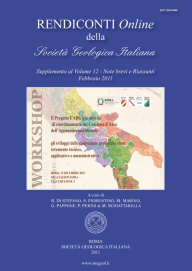
Il contributo della cartografia CARG negli studi di pericolosità sismica. Il Foglio Gran Sasso d'Italia alla luce del terremoto aquilano del 6 aprile 2009
Alberto Pizzi (*), Fernando Calamita (**), Pierluigi Pieruccini (***), Giuseppe Pomposo (*) & Vittorio Scisciani (*)
(*) Dipartimento di Geotecnologie per l'Ambiente ed il Territorio, Università "G. d'Annunzio" di Chieti-Pescara.
(**) Dipartimento di Scienze, Università "G. d'Annunzio" di Chieti- Pescara.
(***) Dipartimento di Scienze della Terra, Università di Siena.
DOI: https://doi.org/
Volume: 12/2011
Pages: 77-81
Abstract
The CARG Project contribution to seismic hazard studies: the "Gran Sasso d'Italia" sheet in the light of the L'Aquila eartquake (April 6, 2009).
After the 6 April 2009 L'Aquila seismic event detailed geological and geophysical investigations produced a great amount of new information about the active faults in the L'Aquila-Gran Sasso area. A few years before the earthquake the area had been investigated for the 1:50.000 Geological Mapping CARG Project and this paper is aimed to underline the contribute provided by the geological maps in order to address detailed studies on seismic hazard in Italy. The 1:50.000 scale Sheet 349 "Gran Sasso d'Italia" has been investigated and realized taking carefully into account the Quaternary fault activity since a wide literature already existed about recent activity of many fault systems of the area. We introduced the category of "Faults with Quaternary activity" classified following detailed structural, sedimentological/stratigraphical, chronological and, at places, paleoseismological investigations. In particular, Quaternary activity was addressed to the "Monte Stabiata Fault", probably reactivated during the L'Aquila seismic sequence (e.g., Boncio et alii, 2010), and even described as active during the late Pleistocene. Therefore, the 1:50.000 scale geological maps of the CARG project may provide helpful and detailed information about the presence of Quaternary structures and their relationship with pre-existing structures (e.g., pre-Quaternary thrusts and normal faults) giving a first step contribution to - warmly recommended - dedicated studies for seismic hazard evaluation.
Keywords
Foglio CARG 349 Gran Sasso d'Italia, faglie ad attività quaternaria, pericolosità sismica, terremoto de L'Aquila del 06/04/2009
Get Full Text